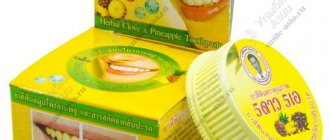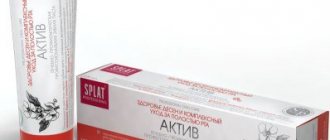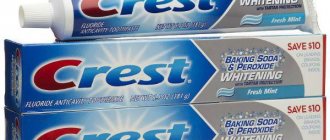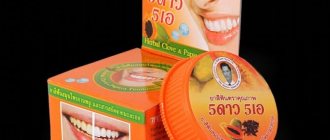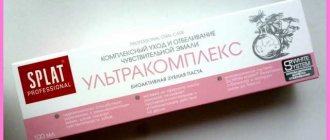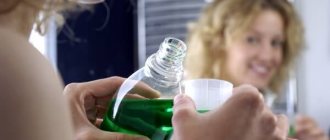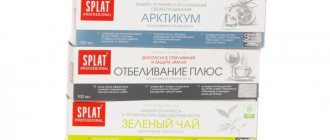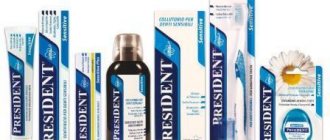Every person has visited the dental clinic more than once. Some did this from a preventative point of view, while others were faced with dental or oral disease.
One of the most unpleasant diseases that causes a person many problems and forces him to seek dental help is pulpitis. This is an inflammatory process that affects a bundle of blood vessels and nerve fibers (pulp) located inside the dental cavity. Dental clinic "Diamant" in Moscow provides services for devitalization of pulpitis.
Arsenic devitalizing paste consists of the following components:
- Arsenic anhydride.
- Elements that have an antiseptic and disinfecting effect on the pulp.
- Pain relieving components.
- Components that ensure long-lasting action of the paste.
- Additional components.
Arsenic in any form is one of the most potent poisons. A dose of 5 mg is toxic for humans, and therefore for devitalization the permissible maximum dose is 3 mg.
If the dose is exceeded, symptoms of intoxication such as vomiting and loose stools may occur.
When arsenic paste is applied to the pulp, gradual necrosis of nerve endings and blood vessels occurs. Since the blood supply is cut off, the pulp dies and the transmission of nerve impulses stops.
Many dentists prefer not to use arsenic paste for devitalization, especially when treating children, pregnant and nursing mothers. Moreover, there are safer and less toxic analogues.
Indications for use of the method.
The indication for pulp extirpation can be any type of pulpitis, including acute diffuse form or chronic fibrous form. Prescribe devitalization
and pulp removal can occur due to tooth injury or for other orthopedic reasons.
The method is also used if other methods of treating pulpitis have failed. Also, the method of devital extirpation
is indicated in cases where the root pulp becomes inflamed after
vital and devital amputation.
Side effects that may appear after using arsenic paste:
- If the dosage is exceeded, signs of intoxication of the body may appear - nausea, vomiting, diarrhea.
- If the paste is applied poorly, it may be washed out or leaked, accompanied by a burn of the oral mucosa with subsequent complications.
- If the paste is kept in the tooth cavity longer than intended, the dentin may change its color - turn black.
- Due to the high toxicity of the paste, periodontitis may begin.
- Swelling of the pulp due to inflammation.
- The effect of the poison can spread to bone and periosteal tissue, causing their destruction.
About the method.
Devital pulp extirpation
this is its complete removal after deprivation of viability. The method is considered quite reliable, as it prevents the spread of infection and the occurrence of periodontitis. In that case, of course, when the procedure is performed efficiently. Devital extirpation is carried out in several stages. Therefore, you will need 3 visits to the dentist's office.
Paraformaldehyde paste - mechanism of action, advantages of use
Paraformaldehyde paste is applied to the tooth for a longer period than arsenic paste. Instead of wearing arsenic paste for a maximum of 48 hours, the patient should undergo paraformaldehyde for 10-14 days. However, this method of devitalization is considered more gentle on the body, since this paste is less toxic. It does not have such an aggressive effect on periodontal tissue as does containing arsenic. This paste promotes the death of pulp vessels and the cessation of its blood supply, but does not cause pathological changes in the periodontium even with prolonged use.
Paraformaldehyde also has a mummifying effect on dying pulp. It “pulls” moisture from the pulp, causing it to dry out.
If it is necessary to devitalize the pulp of a tooth with unformed roots, use only paraformaldehyde paste.
Devit-S (potent paste) (3g)
DEVIT - S - POWERFUL DEVITALIZING PASTE WITHOUT ARSENIC
PURPOSE
- Paste "Devit-S" is used for pulp devitalization in the treatment of pulpitis using the method of mortal extirpation or amputation, for the treatment of residual root pulpitis of temporary and permanent teeth, and also as an additional means for devitalization during a repeated procedure after the use of pastes containing arsenic.
BASIC PROPERTIES
Arsenic-free paste "Devit-S" contains:
- paraformaldehyde is an antiseptic that coagulates albumin, providing pulp devitalization;
- lidocaine hydrochloride, which is a local anesthetic and reduces the risk of painful reactions;
- creosote is an antimicrobial component;
- paste former and filler, giving the paste a fibrous structure.
The use of Devit-S paste ensures prolonged devitalization of the pulp with virtually no irritation and pain, and also eliminates the need for additional treatment of the canals to neutralize arsenic salts, as is the case with the use of arsenic pastes.
MODE OF APPLICATION
- Clean the cavity from carious dentin and open the pulp chamber.
- Introduce the required amount of paste using a probe (without pressure) into a well-opened (or open) cavity. In case of significant necrosis of the pulp surface, it is necessary to remove part of the necrotic pulp under application anesthesia.
- The amount of paste is determined individually.
- When treating pulpitis of baby teeth, as well as single-rooted teeth in adults, it is enough to apply the paste in an amount equal to the size of millet grain.
- To devitalize the pulp of multi-rooted teeth, the amount of paste must be doubled.
- After applying the Devit-S paste, it is necessary to hermetically close the cavity with a temporary filling material (water-based Dentin powder).
- Complete devitalization of the pulp occurs in 3-5 days, in rare cases - in 7 days.
- If the patient does not feel pain, permanent filling can be performed within 24-48 hours after applying the paste.
- If direct contact with the pulp is not achieved, devitalization must be carried out in two stages. Direct contact can only be achieved in the second stage after pulp viability has decreased.
- After devitalization and extirpation of the pulp, instrumental and medicinal treatment of the canal is necessary (a set of EndoZhi fluids).
Precautions: The patient should be instructed to immediately seek medical attention if they experience a creosote taste in the mouth, which indicates leakage of the devitalizing paste through the temporary filling.
Note: The drug is contraindicated for persons with hypersensitivity to paraformaldehyde. If pulpal pain intensifies after applying the paste (the pulp horn is not exposed or the paste is applied very tightly), it is necessary to perform infiltration anesthesia with lidocaine.
RELEASE FORM
- Paste (syringe) - 3.0 g
STORAGE CONDITIONS Store in a dry place, protected from direct sunlight, in a tightly closed container, at a temperature from +5°C to +20°C. Seal tightly after each use.
Shelf life – 2 years.
When is such a procedure necessary?
The procedure is also carried out when opening the pulp chamber due to mechanical damage to the tooth or due to inadequate dental interventions. In addition, surgery may be required if it is necessary to prepare teeth for prosthetics, when the likelihood of inflammation developing under artificial structures should be completely eliminated.
Composition of these funds
Arsenic acid (As2O3) is present in arsenic-based devitalizing pastes. Arsenic-free pastes, which are used for pulp devitalization, contain phenol, formaldehyde (formalin) and a combination of their derivatives. In arsenic-free pastes, formaldehyde powder is mixed with creosote, glycerin or petroleum jelly. Their effect is somewhat weaker and less reliable than pastes containing arsenic, and with an insufficient period of exposure, instead of necrosis of the dental pulp, only its mummification (sclerosation) can be achieved. However, the purpose of such manipulation may be precisely this effect: with the amputation technique, in the case of dental therapy in children, the sclerotic pulp, which is left in the microtubules, is aseptic and will no longer cause an inflammatory process.
Such devitalizing pastes include “Paraform”, “Paraformaldehyde”, “Trioxymethylene”, “Formalin”, “Asphalin” and “Triopasta”. The last three drugs are made on the basis of formaldehyde, however, the use of the latter turns out to be more effective when summing up the results of such a dental procedure, because during therapy using amputation techniques, the pulp stump prevents the diffusion of formaldehyde into the periapical spaces.
The use of, for example, asphaline paste most often leads to the development of reactive periodontitis. When using a paste containing paraformaldehyde, lidocaine and phenol, its effect lasts from 5 to 8 days, but has a lighter effect, without irritation or disruption of periodontal structures. There are no specific features when applying paraformaldehyde pastes - they are the same as for arsenic pastes.
Various manufacturers produce both arsenic-free devitalizing pastes and those with arsenic in their composition, which make it possible not only to achieve the expected effect, but also to plan a schedule for the patient to visit the dental office. For example, the use of “Devit-A” paste, which has a pronounced anesthetic effect, helps relieve severe pain during the treatment of acute pulpitis, “Devit-P” - to achieve mummification of the pulp of milk teeth and prevent its extirpation, and “Devit-S” - to use by the method of mortal amputation or exirpation in the treatment of residual symptoms of root pulpitis, both in temporary teeth and permanent ones.
First visit to the dentist.
On the first visit, a complete sanitation of the diseased tooth is carried out. After anesthesia, all infected tissues are removed, the tooth is treated with medications and an opening is created to access the pulp. A small amount of arsenic paste is placed there. Which should kill the tissue. In teeth with one root, this process takes a day; for teeth with two roots, it will take 48 hours. If the second visit cannot be scheduled so quickly, then a similar substance is given, only with a slower effect. For a period of one to two weeks. After placing the paste, the hole is closed with a temporary bandage.
Reviews of these pastes
There are relatively few reviews of devitalizing pastes on medical websites, and they are left mainly by dental specialists who use such drugs in daily clinical practice. Dentists say that arsenic pastes are more reliable, but they are very dangerous to health and are not used in the treatment of children's teeth. Arsenic-free drugs such as Devit are the most popular, even though they do not have such strength. However, according to dentists, they do an excellent job with their main task, and in addition they effectively relieve pain, which is very important in dental therapy. Today they are most often used in dentistry.
Types of pastes
The arsenal of medical products for dental devitalization includes:
- depulping pastes that contain arsenic compounds, as well as devitalizing pastes without arsenic, produced on the basis of formaldehyde;
- using the technique of electrochemical pulp necrosis.
Despite the pronounced toxic effects of arsenic, the need for precise dosing and strict adherence to the period of stay of medical preparations containing it in the pulp cavities, its use for pulp devitalization is quite advisable and justified by many arguments. Devitalizing pastes based on arsenic kill the pulp very reliably, painlessly and quickly.
